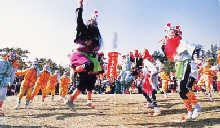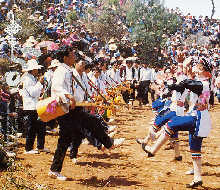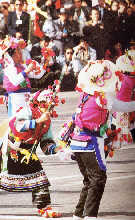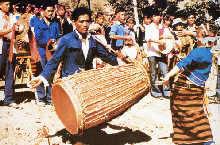Anhui Volume:Huagudeng (Flower DrumLantern)
Flower Drum Lantern, popular in more than 20 cities and counties of Huainan, Fengtai, Huaiyuan, Yingshang, etc. along the Huai River throughAnhui Province, is a comprehensive folk art form which includes dancing, singing, gong and drum beating, martial art andacrobaticsperformed on festival and seasonal occasions.
Dancing is the major element of Huagudeng which consists of "Dachang", is "Xiaochang" and "Pangu" while "Dachang" is is a group dance; Xiaochang a narrative dance of two or three dancers and its central part and Pangu shows a good combination of dancing, martial arts and technical skills with a taste of plastic arts.Whenever the Spring Festival arrives, the dancing teams of each village and rural area compete with each other in rushing off to dance in thetemples and at the fairs, and sometimes there are one or several dozens of teams dancing there, which draws a colorful painting with a strong taste of rustic folklore.
Guangdong Volume: Yingge
 Yingge has several names with the similar pronunciation in Chinese, such as "Yinge", "Yangge" and "Yingge", which are popular inChaozhou, Shantou, etc. and prosperous in the two cities of Puning and Chaoyang of Guangdong Province.
Yingge has several names with the similar pronunciation in Chinese, such as "Yinge", "Yangge" and "Yingge", which are popular inChaozhou, Shantou, etc. and prosperous in the two cities of Puning and Chaoyang of Guangdong Province.
There are three different sizes of the dancing teams according to the numbers written in the Tale of the Waterside: 36 members (Heavenly Gods), 72 members (Earthly Gods) and 108 members (Heroes in the Liangshan Mountain), each dancer uses thefacial makeupclearly in the Chaozhou or Shantou style while based on his imagination of how his hero looks like in this famous novel, which is the most outstanding character of Yingge.
The dancing of Yingge has three types as lento, moderate, and allegro while the steps of the lento are stable, extensive, intoxicated like drunk, and triumphant; the gavel beating of moderate is rich and flexible, with forceful movements and constantly changing patterns; and the movements of allegro are fast but not confused, gradually leading to their extreme and finally coming to its end abruptly.
 Life Dances
Life Dances
Yunnan Volume: Axitiaoyue (Axi Dancing to the Moon) of the Yi Ethnic Group
 Axi Dancing to the Moon means dancing for joy and is a favorite folk dance as an entertainment greatly favoured by the Axi People and the Sani People, two branches of the Yi ethnic group inYunnan Province. It is popular in the Counties of Mile, Lunan, Luxi, Yiliang, Qiubi, Luliang, etc. in Yunnan.
Axi Dancing to the Moon means dancing for joy and is a favorite folk dance as an entertainment greatly favoured by the Axi People and the Sani People, two branches of the Yi ethnic group inYunnan Province. It is popular in the Counties of Mile, Lunan, Luxi, Yiliang, Qiubi, Luliang, etc. in Yunnan.
While dancing, the male dancers are playing the Chinese trichord string instrument named Dasanxian on their backs or blowbamboo flutes; and the female dancers greet their male partners with applauses. Together they sometimes form a circle and sometimes face each other in two opposite lines with their armsswingingfreely and torsos turning lightly which make the whole dance quite vivid and vigorous, and arouse great favour among the local people.
Yunnan Volume: Bawangbian (Rattle Stick Dance) of the Bai Ethnic Group
Rattle Stick Dance is the most representative and most widely spread dancing form of the Bai ethnic group in Yunnan Province. It is preformed no only in some traditional folkloric activities such as "Raosanling', "Celebrating the First Lunar Month", "Farmers's Celebration", but also on other occasions such as house-buildings, weddings, or festivals.
Rattle Stick Dance has a long history and was recorded in detail in the poem "Raosanling Zhuzhici" of Duan Wei, a poet of County during theQing Dynasty. The movements are very rich and diverse; therefore, it is a favorite dance.
Yunnan Volume: Waterdrum Dance of the De'ang Ethnic Group
 Waterdrum Dance is popular mainly in the villages of De'ang ethnic group and the Dai people in Bawanxiang of Baoshan City in Yunnnan Province. It is performed at religious gatherings or festival celebrations by the masses of both peoples either on the squares of the Buddisttemples, or in their villages. It is extremely busy and exciting with the water drums, the elephant-foot-shaped drums, the cymbals and Mang gongs of different sizes beaten gloriously. The movements of the dancers are calm and unhurried because of the heavy weight of the waterdrums which gradually becomes a style of its own.
Waterdrum Dance is popular mainly in the villages of De'ang ethnic group and the Dai people in Bawanxiang of Baoshan City in Yunnnan Province. It is performed at religious gatherings or festival celebrations by the masses of both peoples either on the squares of the Buddisttemples, or in their villages. It is extremely busy and exciting with the water drums, the elephant-foot-shaped drums, the cymbals and Mang gongs of different sizes beaten gloriously. The movements of the dancers are calm and unhurried because of the heavy weight of the waterdrums which gradually becomes a style of its own.
